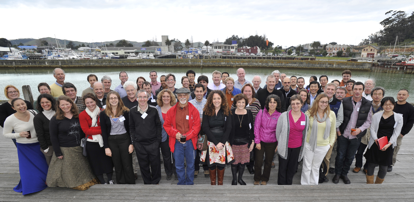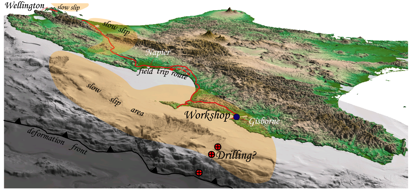Laura Wallace, Eli Silver, Nathan Bangs, Rebecca Bell, Stuart Henrys, Joshu Mountjoy, and Ingo Pecher

Figure 1. Workshop group photo.
From August 1 to 5, 2011, 70 geoscientists and student researchers from a dozen countries gathered in Gisborne, New Zealand, to discuss how scientific ocean drilling can help to elucidate the processes behind slow slip event (SSE) occurrence. Gisborne was chosen as a venue for this workshop due to its close proximity above the source area of shallow slow slip (<5-15 km depth) that occurs at the northern Hikurangi subduction margin in New Zealand.SSEs are a new class of shear slip found at subduction margins around the globe that have revealed the broad spectrum of fault slip behaviour. SSEs are widely acknowledged as one of the most exciting discoveries of the last decade in the Earth Sciences, and have implications for plate boundary processes and the seismic hazard posed by subduction megathrusts. The relatively shallow depths of subduction thrusts exhibiting SSEs in New Zealand (north Hikurangi), central Japan (Boso Peninsula), and Costa Rica (Nicoya Peninsula) (5 – 10 km below seafloor) potentially puts them within reach of IODP drilling. The possibility for direct access to these faults suggests that scientific drilling could play an important role in revealing the physical processes behind SSEs. The main goals of the workshop were to summarize critical requirements of a drilling program to discern the physical mechanisms responsible for SSE behaviour, develop strategies to achieve the scientific goals, determine what types of data are needed to develop an effective drilling program, and identifying the expertise and technologies needed to drill a SSE source area successfully. Additional geophysical experiments in support of any IODP drilling were also addressed.
Oral presentations at the Gisborne workshop were organized into thematic sessions centered around (1) observations of and theories for slow slip event occurrence, (2) lessons learned from previous IODP drilling at subduction zones, and (3) focused talks on potential slow slip drilling targets in New Zealand, Costa Rica, and central Japan. The talks were interspersed each day with breakout discussion sessions and broader group discussions. Breakout sessions over the first 2 days focused on the measurements and experiments needed to understand the origins of SSE and how these plans might be applied to potential IODP drilling projects in New Zealand, Japan, and Costa Rica. On the final day, breakout groups sat down and developed implementation plans for each location.
A number of fundamental conclusions came from the workshop: (1) further development and site characterization is needed at each of the sites to be able to effectively examine slow-slip processes along the plate interface with drilling. At each of the sites, additional data is needed to refine the locations, magnitudes, timing, slip regions, relationship to earthquakes, and cyclicity of SSEs. We concluded that we can achieve these goals with a combination of onshore geodetic and seismic experiments combined with offshore long-term deployment of ocean bottom seismographs equipped with pressure sensors to monitor vertical seafloor deformation. (2) Also critical are complementary, collocated studies for developing regional-scale characterization and development of site locations. These include (but are not limited to): structure and tectonics, physical properties, stratigraphy and lithologies, and thermal structure, using active source 2D and 3D seismic imaging and wide-angle refraction, passive source studies, heat flow surveys, and multibeam seafloor mapping. Auxiliary data are required to both help identify drilling targets and compliment borehole data and monitoring; (3) Shallow level borehole monitoring is key to address questions related to the spatial distribution of slow slip beneath offshore subduction margins, and to reveal the possible relationship between SSEs and normal seismicity, as well as discerning changes in fluid flow and geochemistry within the upper plate during the SSE cycle. Monitoring will be supported with coring and logging for ground truth and detailed characterization of lithology, stratigraphy, structure, fluids, and physical properties above the SSE source regions; (4) Drilling, logging and sampling of the SSE source area will provide the most direct information on the physical conditions (frictional properties, mineralogical composition, fluid pressure conditions, temperature, among others) that lead to and control slow slip event behaviour. Participants agreed that deep drilling of an SSE source area is within reach and is the ultimate way to solve the mystery of why SSEs occur.

Figure 2. Oblique view of the Hikurangi subduction margin, including locations of slow slip (orange shaded), the location of the workshop and fieldtrip route, and the proposed slow slip event drilling targets offshore Gisborne.
One of the interesting discoveries during the workshop was the realization by participants that the world’s best-documented areas of shallow (<20 km depth) slow slip events in Costa Rica, central Japan and New Zealand have some striking similarities. Specifically the 3 margins include: relatively cold temperatures on the interface in the SSE source regions, similar slow slip event durations (generally ~2-3 weeks), and comparable equivalent moment magnitudes per event (Mw ~6.5). Costa Rica and north Hikurangi have further similarities in that both margins are characterized by subduction erosion, and each exhibit a regular two-year SSE recurrence interval. We expect that continued comparison and contrasting of these 3 subduction zones and their shallow slow slip event behavior begun at the workshop will lead to new insights into the mechanisms behind shallow SSEs.
The main 3-day workshop was followed by a 2-day field trip, from Gisborne to Wellington. The fieldtrip was designed to expose participants to the onshore, uplifted components of the Hikurangi forearc and provide a complete transect of Hikurangi margin active tectonics. The fieldtrip also tracked above the slow slip event source areas of the Hikurangi subduction zone, and gave participants insights into the geological and tectonic context of slow slip in the North Island.
Just after the fieldtrip, on 6-7 Aug approximately 45 of the Gisborne workshop participants met to develop the full proposals and implementation plans for a proposed project to use IODP drilling to understand slow slip event processes offshore Gisborne, at the northern Hikurangi margin. We expect that these efforts will be of interest to the GeoPRISMS community, as New Zealand has been recently selected as one of the primary focus sites for the Subduction Cycles and Deformation (SCD) program. The evolving effort towards IODP drilling at north Hikurangi may provide an important focal point for SCD research in the New Zealand region in the coming years.
The workshop was supported by funding from IODP-MI, the New Zealand Ministry of Science and Innovation, the Consortium for Ocean Leadership, and GeoPRISMS. A full report on the workshop outcomes will be developed for IODP over the next few months, and will be publicly available once it is completed.
GeoPRISMS Newsletter, Issue No. 27, Fall 2011. Retrieved from http://geoprisms.nineplanetsllc.com
